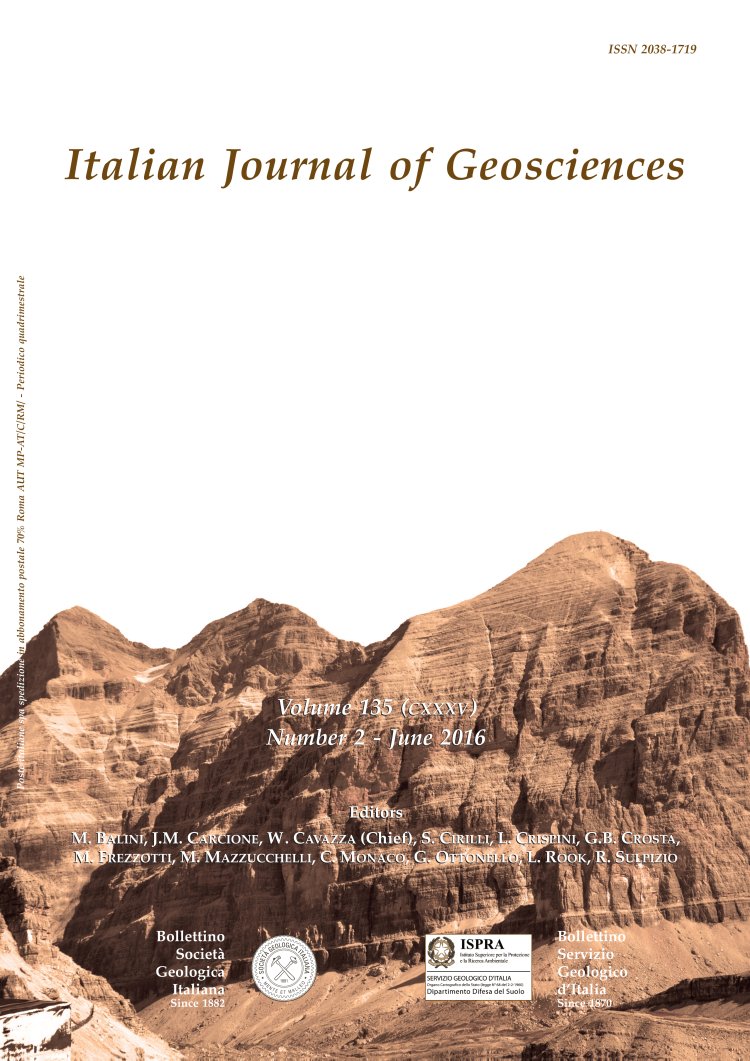
Geological reconstruction in the area of maximum co-seismic subsidence during the 2009 Mw=6.1 L'Aquila earthquake using geophysical and borehole data
Massimiliano Porreca (1), Alessandra Smedile (2), Fabio Speranza (2), Tania Mochales (2), Francesca D'ajello Caracciolo (2), Giuseppe Di Giulio (2), Maurizio Vassallo (2), Fabio Villani (2), Iacopo Nicolosi (2), Roberto Carluccio (2), Sara Amoroso (2), Patrizia Macrì (2), Nicoletta Buratti (3), Federica Durante (4), Marco Tallini (4) & Leonardo Sagnotti (2)
(1) Università di Perugia, Dipartimento di Fisica e Geologia. Corresponding author e-mail: massimiliano.porreca@unipg.it
(2) Istituto Nazionale di Geofisica e Vulcanologia.
(3) Total SA, CSTJF.
(4) Università de L'Aquila, Dipartimento di Ingegneria.
Volume: 135 (2016) f.2
Pages: 350-362
Abstract
InSAR images showed that the 2009 Mw=6.1 normal faulting L'Aquila earthquake (Abruzzi region, central Italy) produced a maximum co-seismic subsidence of ca. 24 cm in the epicentral area.
We report new results about the stratigraphic architecture of this area by means of the integration of geophysical and stratigraphic data from a new 151 m deep borehole. According to the indication of preliminary geophysical (electrical resistivity tomography and seismic noise) surveys, the borehole was drilled where maximum thicknesses of fine-grained sediments were expected. The geophysical results were also useful to estimate the basin substrate depth and to define the geometry of the continental deposits, successively constrained by the core stratigraphy.
The core is characterized by two sequences separated by an erosional discontinuity. The upper sequence is composed by silty, sandy and gravelly deposits, mainly characterized by high values of electrical resistivity. The lower sequence is characterized by prevalence of grey clayey silt and sandy sediments, with low values of resistivity. Based on correlations among the stratigraphic core and outcrop data of the Aterno Valley, we interpret the upper sequence as related to fluvial-alluvial depositional environment during Middle Pleistocene-Holocene, whereas the lower sequence is related to deposition in a prevalent marshy floodplain environment during Early Pleistocene.
We report new results about the stratigraphic architecture of this area by means of the integration of geophysical and stratigraphic data from a new 151 m deep borehole. According to the indication of preliminary geophysical (electrical resistivity tomography and seismic noise) surveys, the borehole was drilled where maximum thicknesses of fine-grained sediments were expected. The geophysical results were also useful to estimate the basin substrate depth and to define the geometry of the continental deposits, successively constrained by the core stratigraphy.
The core is characterized by two sequences separated by an erosional discontinuity. The upper sequence is composed by silty, sandy and gravelly deposits, mainly characterized by high values of electrical resistivity. The lower sequence is characterized by prevalence of grey clayey silt and sandy sediments, with low values of resistivity. Based on correlations among the stratigraphic core and outcrop data of the Aterno Valley, we interpret the upper sequence as related to fluvial-alluvial depositional environment during Middle Pleistocene-Holocene, whereas the lower sequence is related to deposition in a prevalent marshy floodplain environment during Early Pleistocene.
Keywords
Get Full Text